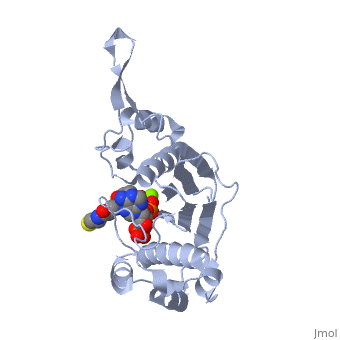Molecular Playground/4'-PHOSPHOPANTETHEINYL TRANSFERASE (Sfp)
From Proteopedia
(Difference between revisions)
| Line 4: | Line 4: | ||
== Introduction == | == Introduction == | ||
| - | '''Sfp''' is a 4'-phosphopantetheinyl (PPant) transferase endogenous to ''B. Subtilis'', first crystallized in 1999 [1]. The function of Sfp is to transfer a phosphopantetheinyl group from <scene name='Sfp/Coa_highlight/ | + | '''Sfp''' is a 4'-phosphopantetheinyl (PPant) transferase endogenous to ''B. Subtilis'', first crystallized in 1999 [1]. The function of Sfp is to transfer a phosphopantetheinyl group from <scene name='Sfp/Coa_highlight/3'>coenzyme-A</scene> (CoA-SH) to the serine residue of peptides containing the sequence "DSL". Frequently this sequence is found in acyl- or peptidyl-carrier proteins in fatty acid synthases (FASs), polyketide synthases (PKSs), and nonribosomal peptide synthetases (NRPSs). This converts the inactive apo form peptide to the active holo form. The terminal thiol PPant prosthetic group acts as a point of covalent attachment between the peptide and the growing fatty acid, polyketide, or nonribosomal peptide. |
Revision as of 17:23, 10 October 2012
4'-PHOSPHOPANTETHEINYL TRANSFERASE SFP
| |||||||||||
Proteopedia Page Contributors and Editors (what is this?)
Jon Amoroso, Gitanjeli Prasad, Lawrence Sheringham Borketey, Carrie Morrison Penland

